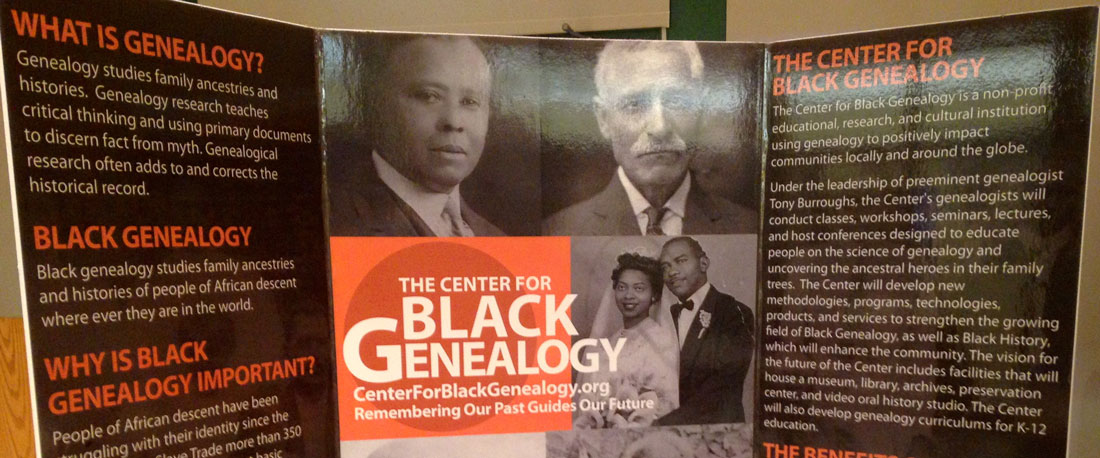By Branden Hampton
If you think that black lives matter, then ancestors’ lives matter as well: Without them, we wouldn’t be here today, says renowned African American genealogist Tony Burroughs.
“Genealogy is important for many reasons. Once you start researching your family history and finding your ancestors, you might find that some of them were activists in their struggles during their days, like our activists in Black Lives Matter today,” said Burroughs.
Burroughs is the founder and CEO of the Center for Black Genealogy and has worked on high-profile cases tracking the ancestry of well-known public figures such as Oprah Winfrey and Rev. Al Sharpton. Burroughs has won a distinguished service award from the National Genealogy Society and has traced his own family tree back eight generations. He has taught genealogy at Chicago State University, or CSU, for 15 years.
CSU alumni, current students, and aspiring genealogists learned how to track down their ancestors during a recent panel discussion with Burroughs and four other speakers, who shared their stories about finding their ancestors. The event was a part of CSU’s Black History Month events.

Going through family archives
Burroughs said that his mother, Mary Ellen Burroughs, was an organizer at the Burnside School sit-in in 1962, which was the first demonstration to desegregate Chicago Public Schools.
“What I didn’t know until I started tracing my family history was that she and the other PTA mothers inspired ministers to get involved in the movement. They also inspired civil rights workers to get involved in the sit-in movement,” said Burroughs.
Burroughs explained that people can start tracing their ancestors by going though their family archives–in his words, “anywhere and everywhere around the house where you have a document, an artifact or photograph that has to do with your ancestors.”
One audience member said Burroughs’ speech provided inspiration for her search.
“It gave me the courage to keep on with my genealogy. Everything is not online. That’s the most important thing,” said Jewel Boganey, who is an alumni of CSU.
Ivy Dunn, associate dean of the College of Arts and Sciences at CSU, began her search by reviewing her great-grandmother’s death certificate. “From there, I was able to learn her father’s name and after that I started looking for the family on the census.”
Dunn also said that she decided to have her mother undergo DNA testing through the popular genealogy site Ancestry.com. Dunn found that her mother is 73 percent African, less than 1 percent Native American, less than 1 percent Asian and 25 percent European.
“When you’re on Ancestry.com, they let you know if anyone matches your DNA. They will tell you if any of your cousins have already been tested by their system,” Dunn noted.
Testing DNA is becoming increasingly popular. According to a spokesperson from Ancestry.com, AncestryDNA has a database with DNA samples from 1.5 million people. For privacy, the results of the DNA test are stored in an encrypted database and the lab processing personnel don’t have access to personal information, according to the organization.
Dunn said that she found out that her mother’s fourth cousin is not African-American at all, but European-American.
Lewis Nixon, president of the Center for Black Genealogy, got started in genealogy in 2000 because it was his turn to plan a family reunion.
“Sixteen years later, I can say that I’ve done some of the same things that Tony and Ivy and others have done. I’ve been able to trace my [family’s] slave owner,” Nixon said.
Another audience member echoed Nixon’s experience.
“I am very interested in my ancestral history and I’m also planning a family reunion in 2017,” said Margaret Gilkey, an alumni of CSU. “There’s a lot of information that I don’t know about and I would like to obtain it to pass on to my children and my grandchildren.”
Obituaries, Bibles as information sources
Burroughs’ late grandfather, Asa Morris Burroughs, was a source of information for him about the family history. Asa Burroughs was an attorney who won a lawsuit against Northwestern University involving a challenge to an old policy excluding black students from dorms on campus.
Another source of information for genealogists, Burroughs said, are old obituaries that were clipped from newspapers and passed down from generation to generation. Plus, there’s the National Archives in Washington, D.C., where people can see Bibles that were used by former military veterans who “wanted to prove how old they were.”
Kelly Ellis, chair of the CSU’s department of foreign languages and literature, said that she started working on a collection of poems on her great -grandfather about 10 years ago. “Stories had been in my head forever because he talked to me constantly and he told stories,” Ellis said.
Ellis also mentioned that research and imagination gave her poems texture and she wanted to imagine her great-grandfather meeting her great -grandmother.
Burroughs said that people can begin tracing their ancestry by simply talking to their relatives.
“We need to get their stories while they’re still alive,” Burroughs said.” Alex Haley had a saying that when an older person dies, it’s like a library burns and they take everything with them.”

